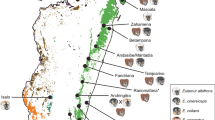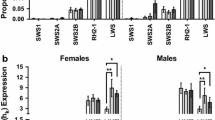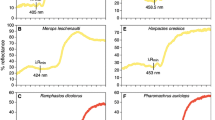Abstract
Primate color vision has traditionally been examined in the context of diurnal activity, but recent genetic and ecological studies suggest that color vision plays a role in nocturnal primate behavior and ecology as well. In this study, we united molecular analyses of cone visual pigment (opsin) genes with visual modeling analyses of food items to explore the evolution of color vision in the folivorous woolly lemur (genus Avahi). Previous studies have shown that leaf quality, e.g., protein content, leaf toughness, and protein/toughness ratio, is significantly correlated with green-red and blue-yellow chromatic differences, suggesting a potential role of color in leaf discrimination in Avahi, and, consequently, a potential adaptive advantage to color vision in this taxon. Phylogenetic selection tests determined that the strength of selection on the SWS1 opsin gene to retain blue-sensitive SWS cones did not significantly differ in Avahi compared to day-active primates. Genotyping of the M/LWS opsin gene in 60 individuals from nine species found that the 558-nm-sensitive (red-sensitive) allele is conserved across all Avahi. Finally, we measured spectral reflectance from five species of young leaves consumed by Avahi and background foliage in Ranomafana National Park and modeled performance of possible S and M/L pigment pairs for detecting these food items under different nocturnal illuminations (e.g. twilight, moonlight). We found that the observed cone pigment pair in Avahi was optimally tuned for color-based detection of young green leaves in all nocturnal light environments, suggesting a potential adaptive role of nocturnal color vision in selection for dichromacy in this genus.





Similar content being viewed by others
References
Andriantompohavana, R., Lei, R., Zaonarivelo, J. R., Engberg, S. E., Nalanirina, G., McGuire, S. M., et al. (2007). Molecular phylogeny and taxonomic revision of the woolly lemurs, genus Avahi (Primates: Lemuriformes). Lubbock, TX: Museum of Texas Tech University.
Baayen, R. H. (2011). Data sets and functions with ‘Analyzing Linguistic Data: A practical introduction to statistics’. R package version 1.4. http://CRAN.R-project.org/package=languageR.
Barton, R. A. (1998). Visual specialization and brain evolution in primates. Proceedings of the Royal Society of London B: Biological Sciences, 265(1409), 1933–1937.
Bates, D., Maechler, M., & Bolker, B. (2012). lme4: Linear mixed-effects models using S4 classes. R package version 0.999999-0. http://CRAN.R-project.org/package=lme4.
Bearder, S. K., Nekaris, K. A. I., & Buzzell, C. (2002). Dangers in the night: Are some nocturnal primates afraid of the dark? In L. Miller (Ed.), Eat or be eaten: Predator sensitive foraging among primates (pp. 21–43). New York: Cambridge University Press.
Bearder, S. K., Nekaris, K. A. I., & Curtis, D. J. (2006). A re-evaluation of the role of vision in the activity and communication of nocturnal primates. Folia Primatologica, 77(1–2), 50–71.
Bicca-Marques, J. C., & Garber, P. A. (2004). Use of spatial, visual, and olfactory information during foraging in wild nocturnal and diurnal anthropoids: A field experiment comparing Aotus, Callicebus, and Saguinus. American Journal of Primatology, 62(3), 171–187.
Bradley, B. J., MacFie, T., Lawler, R., Morelli, T. L., Louis, E. E., Pastorini, J., et al. (2009). Eye of the beholder: Variable color vision in wild lemur populations. American Journal of Physical Anthropology, 138(S48), 96–97.
Carvalho, L. S., Davies, W. L., Robinson, P. R., & Hunt, D. M. (2012). Spectral tuning and evolution of primate short-wavelength-sensitive visual pigments. Proceedings of the Royal Society B: Biological Sciences, 279(1727), 387–393.
Chatterjee, S., & Callaway, E. M. (2002). S cone contributions to the magnocellular visual pathway in macaque monkey. Neuron, 35(6), 1135–1146.
Cummings, M. E. (2004). Modelling divergence in luminance and chromatic detection performance across measured divergence in surfperch (Embiotocidae) habitats. Vision Research, 44(11), 1127–1145.
Dominy, N. J., & Lucas, P. W. (2004). Significance of color, calories, and climate to the visual ecology of catarrhines. American Journal of Primatology, 62(3), 189–207.
Faulkner, A. L., & Lehman, S. M. (2006). Feeding patterns in a small-bodied nocturnal folivore (Avahi laniger) and the influence of leaf chemistry: A preliminary study. Folia Primatologica, 77(3), 218–227.
Ganzhorn, J. U. (1988). Food partitioning among Malagasy primates. Oecologia, 75(3), 436–450.
Ganzhorn, J. U., Abraham, J., & Razanahoera-Rakotomalala, M. (1985). Some aspects of the natural history and food selection of Avahi laniger. Primates, 26(4), 452–463.
Govardovskii, V. I., Fyhrquist, N., Reuter, T., Kuzmin, D. G., & Donner, K. (2000). In search of the visual pigment template. Visual Neuroscience, 17(4), 509–528.
Griffin, R. H., Matthews, L. J., & Nunn, C. L. (2012). Evolutionary disequilibrium and activity period in primates: a Bayesian phylogenetic approach. American Journal of Physical Anthropology, 147(3), 409–416.
Harcourt, C. (1991). Diet and behaviour of a nocturnal lemur, Avahi laniger, in the wild. Journal of Zoology, 223(4), 667–674.
Heesy, C. P. (2008). Ecomorphology of orbit orientation and the adaptive significance of binocular vision in primates and other mammals. Brain, Behavior and Evolution, 71(1), 54–67.
Jacobs, G. H. (2009). Evolution of colour vision in mammals. Philosophical Transactions of the Royal Society B: Biological Sciences, 364(1531), 2957–2967.
Jacobs, G. H. (2013). Losses of functional opsin genes, short-wavelength cone photopigments, and color vision-A significant trend in the evolution of mammalian vision. Visual Neuroscience early view, 1–15.
Jacobs, G. H., & Deegan, J. F. (1993). Photopigments underlying color vision in ringtail lemurs (Lemur catta) and brown lemurs (Eulemur fulvus). American Journal of Primatology, 30(3), 243–256.
Jacobs, G. H., Deegan, J. F., II, Tan, Y., & Li, W.-H. (2002). Opsin gene and photopigment polymorphism in a prosimian primate. Vision Research, 42(1), 11–18.
Kamilar, J. M., Heesy, C. P., & Bradley, B. J. (2013). Did trichromatic color vision and red hair color coevolve in primates? American Journal of Primatology, 75(7), 740–751.
Kawamura, S., & Kubotera, N. (2004). Ancestral loss of short wave-sensitive cone visual pigment in lorisiform prosimians, contrasting with its strict conservation in other prosimians. Journal of Molecular Evolution, 58(3), 314–321.
Kirk, E. C. (2006). Effects of activity pattern on eye size and orbital aperture size in primates. Journal of Human Evolution, 51(2), 159–170.
Kirk, E. C., & Kay, R. F. (2004). The evolution of high visual acuity in the Anthropoidea. In C. F. Ross & R. F. Kay (Eds.), Anthropoid origins: New visions (pp. 539–602). New York: Kluwer Academic/Plenum Press.
Li, W., & DeVries, S. H. (2006). Bipolar cell pathways for color and luminance vision in a dichromatic mammalian retina. Nature Neuroscience, 9(5), 669–675.
Lucas, P. W., Dominy, N. J., Riba-Hernandez, P., Stoner, K. E., Yamashita, N., Loría-Calderón, E., Petersen-Pereira, W., Rojas-Durán, Y., Salas-Pena, R., Solis-Madrigal, S., Osorio, D., & Darvell, B. W. (2003). Evolution and function of routine trichromatic vision in primates. Evolution, 57(11), 2636–2643.
Melin, A. D., Matsushita, Y., Moritz, G. L., Dominy, N. J., & Kawamura, S. (2013). Inferred L/M cone opsin polymorphism of ancestral tarsiers sheds dim light on the origin of anthropoid primates. Proceedings of the Royal Society of London B: Biological Sciences, 280(1759), 20130189.
Melin, A. D., Moritz, G. L., Fosbury, R. A. E., Kawamura, S., & Dominy, N. J. (2012). Why aye-ayes see blue. American Journal of Primatology, 74(3), 185–192.
Mollon, J. D. (1989). ‘Tho’ she kneel’d in that place where they grew…’ The uses and origins of primate colour vision. Journal of Experimental Biology, 146(1), 21–38.
Moritz, G. L., & Dominy, N. J. (2010). Selective advantages of mono- and dichromatic vision among nocturnal primates. Journal of Vision, 10(15), 1–1.
Nekaris, K. A. I. (2005). Foraging behaviour of the slender loris (Loris lydekkerianus lydekkerianus): Implications for theories of primate origins. Journal of Human Evolution, 49(3), 289–300.
Norscia, I., Ramanamanjato, J., & Ganzhorn, J. U. (2012). Feeding patterns and dietary profile of nocturnal southern woolly lemurs (Avahi meridionalis) in Southeast Madagascar. International Journal of Primatology, 33(1), 150–167.
Peichl, L., Rakotondraparany, F., Kaiser, A., Goodman, S. M., & Kappeler, P. M. (2004). Cone types and distributions in nocturnal and diurnal lemurs of Madagascar. This paper presented at the XVI International Congress of Eye Research, Sydney.
Perry, G. H., Martin, R. D., & Verrelli, B. C. (2007). Signatures of functional constraint at aye-aye opsin genes: The potential of adaptive color vision in a nocturnal primate. Molecular Biology and Evolution, 24(9), 1963–1970.
Piep, M., Radespiel, U., Zimmermann, E., Schmidt, S., & Siemers, B. M. (2008). The sensory basis of prey detection in captive-born grey mouse lemurs, Microcebus murinus. Animal Behaviour, 75(3), 871–878.
Posada, D., & Crandall, K. A. (1998). MODELTEST: Testing the model of DNA substitution. Bioinformatics, 14(9), 817–818.
R Core Team (2012). R: a language and environment for statistical computing. Australia, Vienna: R Foundation for Statistical Computing. http://www.R-project.org/
Regan, B. C., Julliot, C., Simmen, B., Viénot, F., Charles-Dominique, P., & Mollon, J. D. (1998). Frugivory and colour vision in Alouatta seniculus, a trichromatic platyrrhine monkey. Vision Research, 38(21), 3321–3327.
Ripamonti, C., Woo, W. L., Crowther, E., & Stockman, A. (2009). The S-cone contribution to luminance depends on the M- and L- cone adaptation levels: Silent surrounds? Journal of Vision, 9(3), 10, 1–16.
Ronquist, F., Teslenko, M., Van Der Mark, P., Ayres, D. L., Darling, A., Höhna, S., et al. (2012). MrBayes 3.2: Efficient Bayesian phylogenetic inference and model choice across a large model space. Systems Biology, 61, 539–542.
Roos, C., Schmitz, J., & Zischler, H. (2004). Primate jumping genes elucidate strepsirrhine phylogeny. Proceedings of the National Academy of Sciences of the USA, 101(29), 10650–10654.
Ross, C. F., & Kirk, E. C. (2007). Evolution of eye size and shape in primates. Journal of Human Evolution, 52(3), 294–313.
Roth, L. S. V., Balkenius, A., & Kelber, A. (2008). The absolute threshold of colour vision in the horse. PLoS ONE, 3(11), e3711.
Siemers, B., Goerlitz, H., Robsomanitrandrasana, E., Piep, M., Ramanamanjato, J.-B., Rakotondravony, D., et al. (2007). Sensory basis of food detection in wild Microcebus murinus. International Journal of Primatology, 28(2), 291–304.
Sumner, P., & Mollon, J. D. (2000). Catarrhine photopigments are optimized for detecting targets against a foliage background. Journal of Experimental Biology, 203(13), 1963–1986.
Surridge, A. K., Osorio, D., & Mundy, N. I. (2003). Evolution and selection of trichromatic vision in primates. Trends in Ecology & Evolution, 18(4), 198–205.
Tamura, K., Peterson, D., Peterson, N., Stecher, G., Nei, M., & Kumar, S. (2011). MEGA5: Molecular evolutionary genetics analysis using maximum likelihood, evolutionary distance, and maximum parsimony methods. Molecular Biology and Evolution, 28(10), 2731–2739.
Tan, Y., & Li, W.-H. (1999). Trichromatic vision in prosimians. Nature, 402(6757), 36–36.
Tan, Y., Yoder, A. D., Yamashita, N., & Li, W.-H. (2005). Evidence from opsin genes rejects nocturnality in ancestral primates. Proceedings of the National Academy of Sciences of the USA, 102(41), 14712–14716.
Thalmann, U. (2001). Food resource characteristics in two nocturnal lemurs with different social behavior: Avahi occidentalis and Lepilemur edwardsi. International Journal of Primatology, 22(2), 287–324.
Umino, Y., Solessio, E., & Barlow, R. B. (2008). Speed, spatial, and temporal tuning of rod and cone vision in mouse. The Journal of Neuroscience, 28(1), 189–198.
Veilleux, C. C., & Bolnick, D. A. (2009). Opsin gene polymorphism predicts trichromacy in a cathemeral lemur. American Journal of Primatology, 71(1), 86–90.
Veilleux, C. C., & Cummings, M. E. (2012). Nocturnal light environments and species ecology: Implications for nocturnal color vision in forests. The Journal of Experimental Biology, 215(Pt 23), 4085–4096.
Veilleux, C. C., & Kirk, E. C. (2009). Visual acuity in the cathemeral strepsirrhine Eulemur macaco flavifrons. American Journal of Primatology, 71(4), 343–352.
Veilleux, C. C., & Lewis, R. J. (2011). Effects of habitat light intensity on mammalian eye shape. Anatomical Record, 294(5), 905–914.
Veilleux, C. C., Louis, E. E., & Bolnick, D. A. (2013). Nocturnal light environments influence color vision and signatures of selection on the OPN1SW gene in nocturnal lemurs. Molecular Biology and Evolution, 30(6), 1420–437.
Walls, G. L. (1942). The vertebrate eye and its adaptive radiation. Bloomfield Hills, MI: The Cranbrook Press.
Yamashita, N., Stoner, K. E., Riba-Hernández, P., Dominy, N. J., & Lucas, P. W. (2005). Light levels used during feeding by primate species with different color vision phenotypes. Behavioral Ecology and Sociobiology, 58(6), 618–629.
Yang, Z. (2007). PAML 4: Phylogenetic analysis by maximum likelihood. Molecular Biology and Evolution, 24(8), 1586–1591.
Acknowledgments
We thank Amanda Melin and Lauren Brent for the opportunity to participate in this special issue and two anonymous reviewers for invaluable comments. We are grateful to Clara Scarry, Kelsey Ellis, Caroline Bailey (OHDZA), and Cynthia Fraser (OHDZA) for comments, discussion, and laboratory assistance. We want to acknowledge the staff, drivers, and field teams of the Madagascar Biodiversity Partnership, ONG for collecting the Avahi genetic samples. We thank the Ministére des Eaux et Foréts, University of Antananarivo, and Madagascar National Parks for permission to conduct research in Madagascar; Institute for the Conservation of Tropical Environments (USA and Madagascar); Centre ValBio staff, especially Rasabo Paul and Pela Auguste for assisting with plant sample identification and collection. We further thank Conservation International, Margot Marsh Biodiversity Foundation, Primate Action Fund, Primate Conservation, Inc., and OHDZA for supporting field expeditions to collect genetic samples; the University of Texas at Austin for research funds to D. A. Bolnick; and Wenner-Gren Foundation, Leakey Foundation, and National Science Foundation (DDIG, BSC 1232535) to R. L. Jacobs for plant sample analysis in Madagascar.
Author information
Authors and Affiliations
Corresponding author
Rights and permissions
About this article
Cite this article
Veilleux, C.C., Jacobs, R.L., Cummings, M.E. et al. Opsin Genes and Visual Ecology in a Nocturnal Folivorous Lemur. Int J Primatol 35, 88–107 (2014). https://doi.org/10.1007/s10764-013-9708-6
Received:
Accepted:
Published:
Issue Date:
DOI: https://doi.org/10.1007/s10764-013-9708-6




